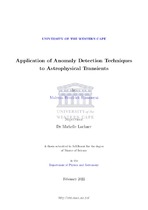| dc.contributor.advisor | Lochner, Michelle | |
| dc.contributor.author | Ramonyai, Malema Hendrick | |
| dc.date.accessioned | 2022-02-24T10:53:59Z | |
| dc.date.available | 2022-02-24T10:53:59Z | |
| dc.date.issued | 2021 | |
| dc.identifier.uri | http://hdl.handle.net/11394/8744 | |
| dc.description | >Magister Scientiae - MSc | en_US |
| dc.description.abstract | We are fast moving into an era where data will be the primary driving factor for discovering new
unknown astronomical objects and also improving our understanding of the current rare astronomical
objects. Wide field survey telescopes such as the Square Kilometer Array (SKA) and Vera C. Rubin
observatory will be producing enormous amounts of data over short timescales. The Rubin observatory
is expected to record ∼ 15 terabytes of data every night during its ten-year Legacy Survey of Space and
Time (LSST), while the SKA will collect ∼100 petabytes of data per day. Fast, automated, and datadriven
techniques, such as machine learning, are required to search for anomalies in these enormous
datasets, as traditional techniques such as manual inspection will take months to fully exploit such
datasets. | en_US |
| dc.language.iso | en | en_US |
| dc.publisher | University of Western Cape | en_US |
| dc.subject | Astronomy | en_US |
| dc.subject | Data | en_US |
| dc.subject | Square Kilometer Array (SKA) | en_US |
| dc.subject | Rubin observatory | en_US |
| dc.subject | Anomaly detection | en_US |
| dc.title | Application of anomaly detection techniques to astrophysical transients | en_US |
| dc.rights.holder | University of Western Cape | en_US |

